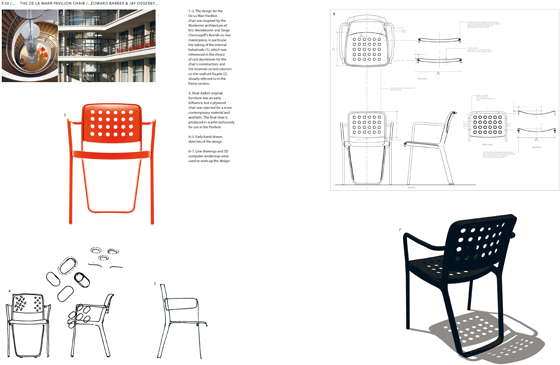'Process: 50 Product Designs from Concept to Manufacture' by Jennifer Hudson
Scritto da Simon Keane-Cowell
Zürich, Svizzera
06.03.10
Architonic reviews design writer Jennifer Hudson's study of the creative and manufacturing processes behind 50 contemporary design objects from around the world.
'It's not where you go, but how you get there that matter mosts.' I remember seeing this rather annoying adage on a slightly dog-eared poster in an upstate New York diner some years ago. Eager that day to get through small-town America and to my destination of Toronto as quickly as possible, I was, I'm afraid to say, all about the destination as opposed to the journey.
In her book 'Process: 50 Product Designs from Concept to Manufacture', design writer Jennifer Hudson asks us to dally a little en route, looking at the backstories, as it were, of a range of furniture and product designs, rather than focusing, as we more often than not do, on their final material manifestions.
Hudson's book opens by suggesting how the 'instant', highly mediatised society in which we now live has skewed our understanding of product design and just what's involved in it as an activity. 'With the proliferation of glossy lifestyle magazines and the publication of bumper compendiums of product design, it is all too easy to believe that the objects of desire with which we seek to surround ourselves are produced virtually overnight.' She goes on to say that 'the designs shown here emphasize that the development of a lasting product is 5% inspiration and 95% hard work.' (I can't help but think here of British comedian Vic Reeves' claim that '88.2% of statistics are made up on the spot.')
Tom Dixon's 'EPS Chair' for the EPS Packaging Group, featured in 'Process' (Laurence King, 2008)
Joking aside, there's a real reason for wanting to make young aspiring designers in particular aware of the demanding process that is involved in the industrial design of products. I'm not sure if it's 'dangerous', as Hudson chooses to describe it in her introduction, but it's certainly unfortunate that design-school graduates are often unaware of just what's involved in designing 'something for the real market and real people', having spent their time as students focusing on self-expression rather than technique and commerciality. Moreover, as has been said for some time, certainly in the UK at least, there's a lack of parity between the sheer volume of the graduates coming out of design courses and the reality of the creative job market. Should we be managing young people's expectations a little better?
BarberOsgerby's 'De La Warr Pavilion Chair' for Established & Sons, featured in 'Process' (Laurence King, 2008)

BarberOsgerby's 'De La Warr Pavilion Chair' for Established & Sons, featured in 'Process' (Laurence King, 2008)
×'Process''s strength is the technical range and the detail of the projects it features. Numerous forms of imagery (photography of prototypes, production processes and finished products, as well as sketches and CAD drawings) are supported by in-depth commentaries (often informed by interviews with the designers), creating valuable narratives that reveal the genesis of such fascinating designs as Stefano Giovannoni's 'Chair First' for Magis, Yves Béhar's 'Leaf Light' for Herman Miller and Konstantin Grcic's 'Miura Stool' for Plank Collezioni. It's great to see a seemingly lo-fi project like Tom Dixon's polystyrene 'EPS Chair' for the EPS Packaging Group, which featured as a grab-one-if-you-can giveaway in Trafalgar Square in 2006 as part of the London Design Festival, receive the full explanatory treatment, while BarberOsgerby's already-classic 'De La Warr Pavilion Chair', which also features in the book, is as ever a joy to behold.
Konstantin Grcic's 'Miura Stool' for Plank Collezioni, featured in 'Process' (Laurence King, 2008)

Konstantin Grcic's 'Miura Stool' for Plank Collezioni, featured in 'Process' (Laurence King, 2008)
×The design of the book itself works well; its layout is considered and the quality of illustrations consistently high. Navigation is fairly straightforward. A glossary of production terms at the back of the book adds real value to the publication. This is a book that sets out to define itself against those aforementioned glossy magazines and bumper design compendia, and achieves this. (Hudson used to be editor of one of those doorstops – the 'International Design Yearbook' – so is perhaps atoning in some way for her past.)
Tom Dixon writes in his 2008 book 'The Interior World of Tom Dixon' (Conran Octopus) that 'I'm slowly coming to the conclusion that design isn't a specific thing that is done to products by experts and that can be measured and judged and quantified as good or bad. Instead I'm starting to see it as a process engaged in by almost everybody, on a daily basis.' If we are all doing it, then it behoves us collectively to be a little more aware of, and by extension thoughtful about, those very processes we are involved in. Hudson's book, in focusing precisely on the how as much as the what of product design, underscores the environmental, social, ethical and other responsibilities that attend it as an activity. This can only be good.
Stefano Giovannoni's 'Chair First' for Magis, featured in 'Process' (Laurence King, 2008)
Whether Hudson will be writing a book on the process of writing 'Process' remains to be seen.
...
'Process: 50 Product Designs from Concept to Manufacture' by Jennifer Hudson
Published by Laurence King Publishing
Paperback
1,088 illustrations
240 pages
280mm x 216mm
ISBN 978 1 85669 541 1
Published 2008







